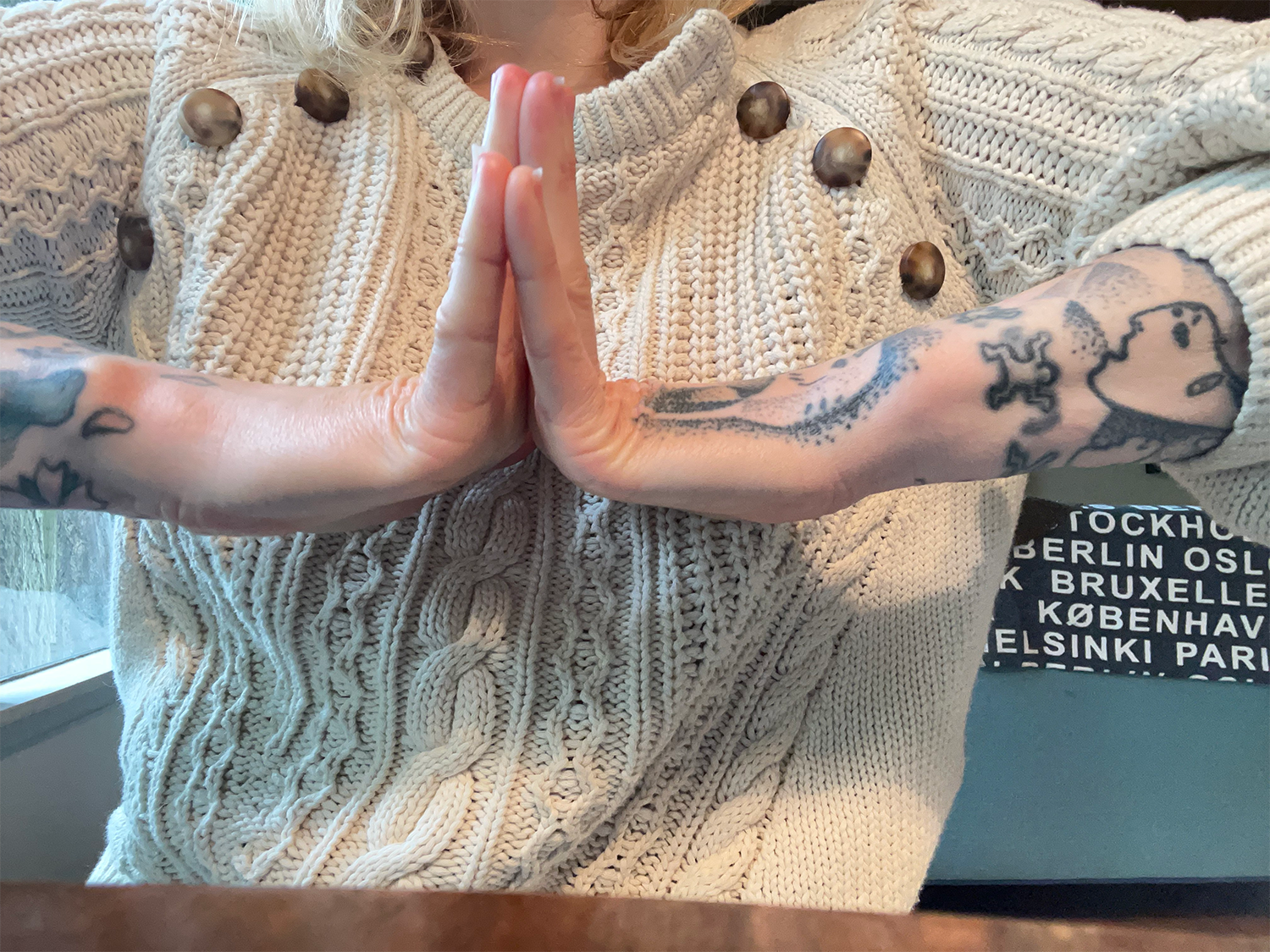Ok, so. Ehlers Danlos!
As I mentioned in a previous post, this particular disorder was on my radar thanks to the many autistics that I follow on social media—many autistics have Eds. I am IMMENSELY grateful that the people I follow have talked about it so much, so that I was able to recognize it in my son (and then myself) and begin creating plans to manage it. And that’s why I’m talking about it now. I hope I can help others figure this out the way so many have helped me.
First, I’m going to talk about Ehlers Danlos, and then I’ll get into the other two pieces of the puzzle that frequently go hand-in-hand with Eds: POTS (Postural orthostatic tachycardia syndrome) and Dysautonomia.
In simplest terms, Ehlers Danlos is a disorder of connective tissue. Our bodies are FULL of connective tissue; connective tissue is our skin, our mouths, our organs, etc. There are 13 types of Ehlers Danlos, classified by what part of the body they impact most. (Vascular Eds, for example, is an especially dangerous type that affects your heart, arteries, etc.). The type that my son and I have is hEds (hypermobile Ehlers Danlos). Hypermobility means that your joints extend beyond the “normal” range (not to be confused with flexibility, which is about the muscles). I consider myself very fortunate, because from what I’ve read about each type, hypermobile Eds is the only type that doesn’t create a shorter life expectancy. (You can read about the different types here.)
I will be writing specifically about hEds (hypermobile).
The first step towards considering hEds is looking at your joint mobility. Surprisingly, up until a few weeks ago, I had no idea that I was hypermobile. I’m not nearly as hypermobile as some people are, but I’m hypermobile enough to be pulling some parlor tricks with my hands. Back when I did yoga, my teachers would warn me to use my muscles more, as I was hyperextending my knees or elbows, but I didn’t realize the extent of it. The first thing I did was assess evaluate my hypermobility using the Beighton Scoring System (which you can find by clicking here). I score 6 out of 9: one point each for each of my knees (2 points total) plus one point each for each of my elbows (2 more points) + one point for being able to bend over and put my palms flat on the ground without bending my knees and + one point for each of my pinkies (2 points total for pinkies) that I can bend back to 90 degrees or greater with my palm flat on a table. 2 (knees)+2 (elbows)+1 (hands to ground)+2 (pinkies) = 7 points. The only thing I can’t do is bend my thumbs back to touch my wrist.
Not part of the diagnostic checklist, but I have super hypermobile shoulders, can do “bird sign” with my hands, as well as bend all my fingers back at a 90 degree angle to my hand, my toes and feet are quite bendy (I used to torture people with “fire toes” pose when I taught yoga… I didn’t realize it was torture for other people!), and apparently not everyone can stretch and splay out their toes the way I can. (My hypermobility is pretty mild, especially compared to my son’s.)
Another criterion on the checklist: “soft, velvety skin” that bruises easily. My husband has been kind of obsessed with how “soft” my skin is since the day he met me. I always thought he was just being cute. Or weird. But he is not the first person I’ve dated who’s commented on this. Now that I know what I’m feeling for, I can notice it in myself. Would you like to stroke my arm? It really is soft and velvety. LOL Anyway, you can find the full checklist here, rather than me reiterating all of it again. But what I’d like to talk about now are the things that AREN’T on the checklist and how it can impact you.
Back when I was around 19, I used to go ice skating with my then-boyfriend (a hockey player). One night, I tripped over my own foot while doing crossovers. I fell and broke my wrist. About two years later, at a Christmas party for the company I was working for part time while going to school in Philly, I fell and broke my ankle. My mom expressed concern that it seemed like I broke bones easily, but I dismissed it as having just fallen “just right.” A lifetime later, my son broke his leg (specifically, his tibia) at school. All he was doing was jumping around in the grass. Everyone was surprised he broke it so easily, but again, we all just figured it was a fluke. He fell “just right.” But now that I know what I know… it’s very clear that we broke bones due to hEds. Here is just one of many papers looking at “higher fracture prevalence and bone size” in Eds.
And then there’s the dental issues. I have severe periodontal disease. I’m currently in the process of having multiple rounds of scaling and root planing (multiple rounds because I can only handle sitting in the chair and going through this process in one-hour chunks). If you look up “periodontal disease,” you’ll often see the causes listed as “genetic” or “poor dental hygiene.” I was baffled about how my gums had gotten so bad, since my oral hygiene is NOT what you’d call bad. But once I realized I have hEds and brought it up to my dentist, she agreed that hEds very likely caused this, as the periodontal tissue around my teeth is degraded and breaking down and it may not regenerate after the scaling and root planing. Now that we know about the hEds, I will probably be going for irrigation and cleanings once every three months for the rest of my life. And I will possibly lose more teeth (I had one pulled already, a couple months ago). I also have a pretty strict oral hygiene routine to follow at home now. The good news is I may be able to prevent my son from going through all of this—now that we know about the hEds, my dentist is going to do an evaluation and start monitoring for this. Although that also means he’ll need to follow a very strict oral hygiene routine for the rest of his life. It’s possible his teeth will be fine—but his hypermobility and the “softness” of his skin is far more than mine, so it’s also very possible he could start losing teeth to periodontal disease as soon as his late-teens or early-twenties if we don’t get on top of it now.
Sleep issues are prevalent among people with Eds—though sleep is also a struggle for autistics (*check*) and people with ADHD (*waves*). So, ya know… I just never sleep. Ok, that’s a bit dramatic, but I can’t say I’ve ever woken up or gotten up in the morning feel good or like I got “good sleep.”
People with hEds often have chronic pain of some form. Several people have told me that “growing pains” in kids is a classic sign. I cannot recall if I experienced this, but I can tell you for certain that my son has. For as long as I can remember, he’s complained of his legs hurting, of aches in his body, random headaches, etc.
I’ve seen some articles stating that there seems to be a link between frequent infections, including ear infections, and Eds. I had VERY frequent ear infections as a kid, though my son has not.
Many people with hEds have dislocated their joints—in my case, I used to dislocate my shoulder A LOT just by sleeping. My shoulders are extremely mobile, as I mentioned already, and they can make some pretty loud, horrific sounds.
I used to wake up in pain all the time, usually from my hips but also my neck. My hips are quite “loose,” as they say. I also get strange bruises on my feet all the time.
I have often suspected I may have Raynaud’s syndrome, which studies suggest have a higher prevalence with hEds – you can look up Raynaud’s for more detail, but a quick summation of my experience: I can be standing in a hot shower and look down to see my toes have a blue tinge and are icy cold.
I cannot grow my nails out, no matter how hard I try. They bend and break, often even bending in the wrong direction if I catch my hand on something.
Constant fatigue.
“Owl neck” (I was seeing a chiropractor a long time ago, trying to get at the source of chronic back pain. She was clearly getting frustrated with me, as there were no structural issues and yet… I always hurt. She had commented once, after assessing my range of motion, that I had an “extremely good” range of motion in my neck.)
Much of my aches and pains have been held at bay simply because I’ve been so much more active in the past several years, and I use an app to remind me to drink enough water. It is highly likely that my poor interoception and impaired proprioception have made it so that I’m not in severe chronic pain 24/7. However, if I do not move every single day or don’t drink enough water, I’m full of aches and pains. (Right now, for example—I was out in PA visiting my mom for a couple of weeks, and it always takes me a couple weeks after returning to Seattle to get back into my routines. Jet lag weirdly always hits me a week later, too. So right now, my body is in agony from being slightly dehydrated and from missing so many days of my 4-mile walks. I’ll feel better once I’m back in my routine, but it takes time to get there.) I often have a “coming down with the flu” feeling when I’m off my routines or not moving enough. “Feeling like you’re coming down with the flu” is something I’ve seen mentioned numerous times in accounts by people with hEds.
But the even bigger symptoms are wrapped up into POTS and dysautonomia. I’ll talk about those next.

